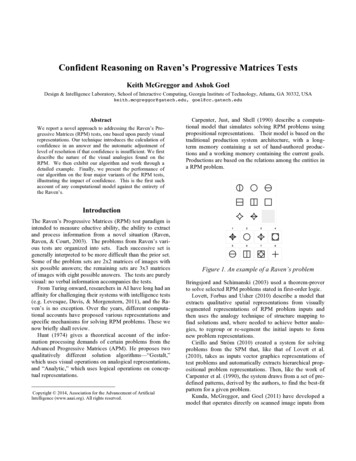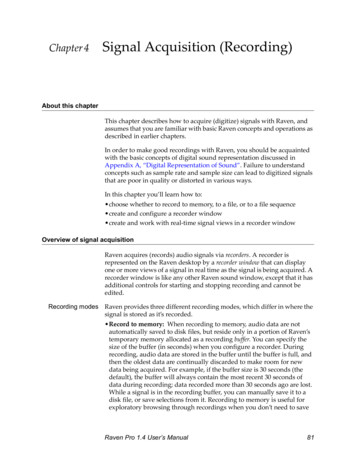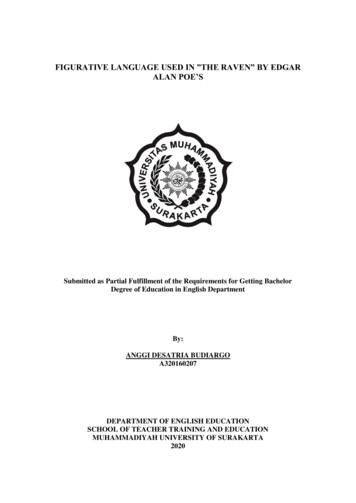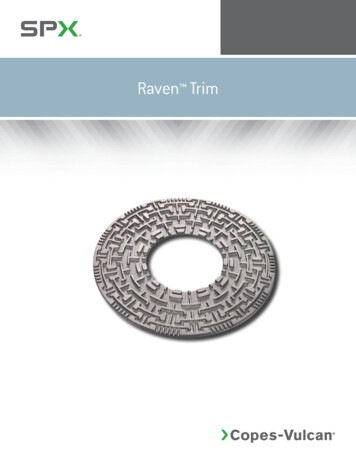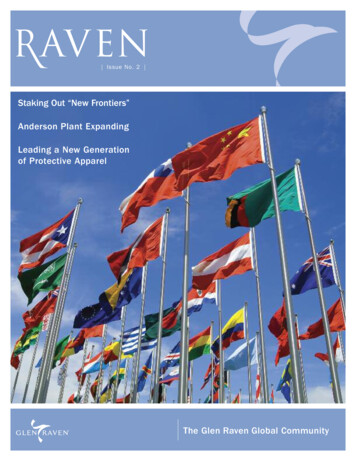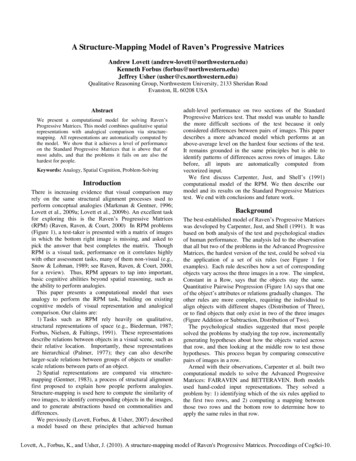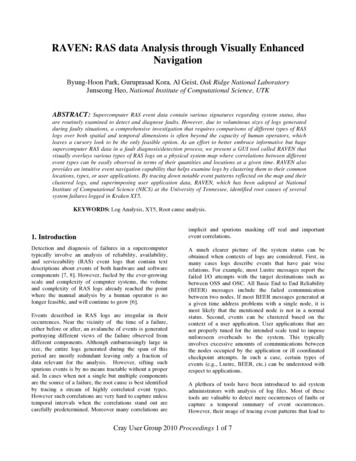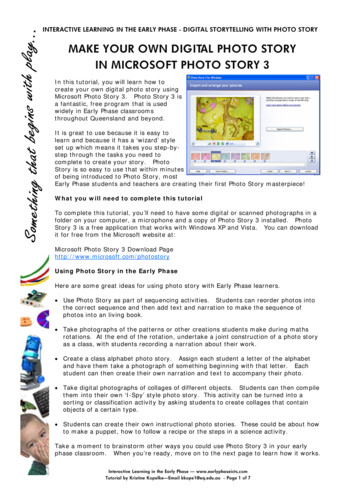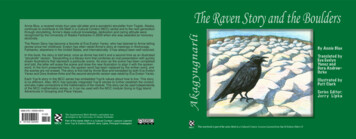
Transcription
The Raven Story has become a favorite of Eva Evelyn Yanez, who has listened to Annie tellingstories since her childhood. Evelyn has often retold Annie’s story at meetings in Anchorage,Fairbanks, elsewhere in the United States, and internationally. It has always been well received.In this book, the story is told twice: once as Annie has told it and a second time as an illustrated“storyknife” version. Storyknifing is a literary form that combines an oral presentation with quicklydrawn illustrations that represent a particular scene. As soon as the scene has been completedand told, the teller will erase the scene and draw the new illustration to align it with the spokenword. In the form presented here, the spoken word has been replaced by the written word, andthe scenes are not erased. The story is first told by Annie Blue and translated by both Eva EvelynYanez and Dora Andrew-Ihrke and the second storyknife version was retold by Eva Evelyn Yanez.Each Yup’ik story in the MCC series has embedded Yup’ik values about how to live. This storyis no different. Also, MCC has typically integrated Yup’ik stories to further establish the contextand also make connections to the mathematics of the module. This story can be used independentlyof the MCC mathematics series, or it can be used with the MCC module Going to Egg Island:Adventures in Grouping and Place Values.AkagyugnarliAnnie Blue, a revered ninety-four-year-old elder and a wonderful storyteller from Togiak, Alaska,continues to contribute to the Math in a Cultural Context (MCC) series and to the next generationthrough storytelling. Annie’s deep cultural knowledge, dedication and caring attitude wererecognized by the University of Alaska Fairbanks in 2009 when she was awarded an honorarydoctorate.The Raven Story and the BouldersThe Supplemental Math Modules curriculum wasdeveloped at the University of Alaska FairbanksMCCPart of the series Math in a Cultural Context: Lessons Learnedfrom Yup’ik Eskimo Elders Jerry Lipka, Principal InvestigatorMCCThis storybook is part of the series Math in a Cultural Context: Lessons Learned from Yup’ik Eskimo Elders By Annie BlueTranslated byEva EvelynYanez andDora AndrewIhrkeIllustrated byPutt ClarkSeries Editor:J e r r y Li p k a
The Raven and the BouldersAkagyugnarli
The Raven and the BouldersAkagyugnarlibyAnnie BlueTranslated by Eva Evelyn Yanez and Dora Andrew-IhrkeIllustrated by Putt ClarkSeries Editor Jerry LipkaThis storybook is part of the series Math in a Cultural Context: Lessons Learned from Yup’ik Eskimo Elders
The Raven and the Boulders: Akagyugnarli by Annie Blue, 2010 University of Alaska Fairbanks,is part of the series Math in a Cultural Context: Lessons Learned from Yup’ik Eskimo Elders.Jerry Lipka: principal investigator and series editor.MCCMath in a Cultural Context: Lessons Learned from Yup’ik Eskimo Elders was developed at the University of Alaska Fairbanks.This material is based upon work supported by the U.S. Department of Education grant #S356A060004,Returning the Gift: Implementing of an Effective Culturally Based Math Curriculum and Professional Development Program.This project was sponsored, in part, by the University of Alaska Fairbanks, Bristol Bay Curriculum Projectand the School of Natural Resources and Agricultural Services.University of Alaska Fairbanks, 2019 2019 University of Alaska Fairbanks. The Raven and the Boulders: Akagyugnarli is licensed under the Creative Commons AttributionNonCommercial-NoDerivatives 4.0 International License. This material may be shared, provided that appropriate credit is given and alink to the license is provided. If changes are made to the material, the modified material may not be distributed. Commercial use isprohibited. To view a copy of this license, visit SNRAS Pub. No. 2010-03ISBN: 978-1-55059-405-8Cover design by Putt ClarkText design by Paula ElmesPrinted in Canada.
AcknowledgmentsAnnie Blue first told this story to Evelyn Yanez in the mid 1950s when Evelyn was a small girl. Evelyn latertranscribed the story when she was a bilin gual coordinator. This story was translated into Yupik in 1994 whenEvelyn was teaching a Yup’ik class for the University of Alaska Fairbanks, Bristol Bay Campus. Her students LindaBrown, Fanny Parker, Grace Pavian, Francis Dock, and Verna Nanalook assisted in this translation; therefore wewould like to acknowledge them for helping produce the first draft of this story. Years later, while working withMCC, Jerry Lipka came up with a big idea: these stories fit well with the Math in a Cultural Context (MCC) mathmodules. That was when Dora Andrew-Ihrke and Evelyn Yanez, with the help of Flor Banks, started writing, editing,retranslating, and turning this story into a version for young children.Annie Blue told those of us who work with MCC a long time ago that “the only reason I want these stories recordedis because I want the children to learn from these stories that I am going to tell you.” Without Annie Blue, this workwould not be possible. She never says no when we ask her to help. She is willing to drop everything and travel toFairbanks and Anchorage when we ask for her assistance. Annie Blue tells us the respect we show her makes herhappy to share her knowledge with us. She is pleased and touched to see that her stories are being brought into thefuture. Annie Blue knows by sharing with us that we will create books (through the MCC project) and pass them onto the next generation.Annie Blue had lots of children; however, many of them died. She says, “The reason I work with you is because youhave taken the place of my de ceased children in my heart. This is why I want to teach you my stories, so you can passthem onto the present and future generations.” She always tells Evelyn Yanez, “These are my stories. I am passing mystories on to you, the way I learned them from the storytellers of the past.” The other people, who know stories, tellv
their stories the way they understood it from their own perspectives. We are all fortunate to work with Annie Blueand to benefit from her unselfish sharing.Jerry Lipka (the principal investigator and editor of the MCC series) is instrumental in bringing us together togather the elders’ knowledge and put it to use in the classroom. His effort to combine math modules and traditionalstories demonstrates the math inherent in Yup’ik activities, language, and crafts. The embedded mathematics is madeexplicit and is taught to teachers so they can pass this knowledge on to their students. In this way we return the giftgiven to us by the elders to their communities and schools. Without Jerry Lipka, this important work would not bepossible.The process of working together is long and slow but worthwhile and a privilege. We acknowledge the cooperationof elders, in particular Mary Active, Mary Bavilla, and Annie Blue, for supporting this effort and Putt Clark for herbeautiful and accurate illustrations based on the elders’ insights and descriptions. We acknowledge bilingual aides,certified Alaska Native teachers, non-Native teachers, mathematicians, and educators for their support and efforts.Thank you to Paula Elmes for the layout and to Nancy Tarnai and Sue Mitchell for the editing. And also thanks toWendy Wood, Loria Chaddon, and Annabelle Roland for their continued support behind the scenes, which enablesproducts like to this to come to fruition. We acknowl edge the efforts of Flor Banks, the project manager, who putsthe pieces together and finds the time to work alongside Evelyn Yanez and Dora Andrew-Ihrke in finalizing themanuscript.vi
About the ContributorsCungauyar, Annie BlueAnnie Blue was born on February 21, 1916, in a place called Qissayaaq on the Togiak River in Alaska. Her mother,Aninautaq, and father, Quriciq Yugg’aq, had nine children. Annie Blue moved to Togiak around 1945, where she stilllives. She married Cingarkaq and had seven children; four sur vived birth. Of these four children, one is still livingtoday. She received a Hail Award for a book of her stories, Cungauyaraam Qulirai, Annie Blue’s Stories.When asked how she became a storyteller, Annie Blue said she remembers listening to Saveskar, the storyteller in hervillage. Annie remembers that while Saveskar was telling her stories, other listeners would start to leave as time wentby. Pretty soon, Annie found herself the only one left listening to Saveskar’s stories. It was important to Annie to stayand listen to the stories because she respected Saveskar. Annie was afraid to offend Saveskar by leaving while she wasstill telling stories. Today, Annie Blue is a respected storyteller, carrying on the oral tradition of Yup’ik storytelling.Dora Andrew-Ihrke is a retired Yup’ik teacher and bilingual coordinator from Dillingham City Schools. She was recognizedas the teacher of the year three times and nationally recognized as the recipient of the Milken Family FoundationNational Education Award in 1990. She also was given the Alaska Federation of Natives Eileen McLean EducatorAward in 2003. She contributes her considerable knowledge of Yup’ik culture and its connec tions to Westernknowledge as a consultant to the MCC project. She contributed some of the supplementary cultural information inthis storybook.vii
Putt Clark was born in Petersburg, Alaska, in 1967, later moving with her family to Fairbanks, where she grew up. Sheattended the University of Alaska Fairbanks, later transferring and graduating from World College West in Petaluma,California, with a BA in arts and society. She has produced all graphics used in the MCC project.Eva Evelyn Yanez, a former Yup’ik teacher and state-recognized bilingual educator, has been involved in education for thepast thirty years. She has ex tensive experience working with Yup’ik elders and collecting, recording, transcribing,and translating traditional Yup’ik stories. She has been involved in the development and production of all the storiesin the MCC series for more than a decade.NotesAlthough there are no guidelines for teachers or questions for students, each of the traditional Yup’ik storiesprovides opportunities for classroom dis cussion about the story and the embedded Yup’ik values. Also, becausethis and other Yup’ik stories in this series are presented from a Yup’ik cultural perspective, they also provide yourstudents with an opportunity to learn about another culture. We also present two versions of the Raven story: (1) ishow Annie Blue told it traditionally, and (2) a storyknifed version in which Evelyn Yanez retells the story. Traditionalstories are to be told the way they were heard, while storyknifing versions allow the teller to make the story theirown. Evelyn, a former teacher, presented the story in a way many children may find quite engaging.viii
IntroductionIn the Togiak area we have huge cliffs and onthe cliffs there are huge boulders.Tuyuryarmi qiurpagtangqertuqteggalvagtar luteng.Once in a while the boulders would rolldown to the beach.Iliini teggalviit elluuraqluteng senamun.Quliirmek niitaqua Tulukarugmek.I have heard this story of the Raven manytimes.Tulukaruut makut waten-wa tua-iqanengssau tuameng ukanirpak.Numerous stories of the Raven have beentold over the years.2
This story begins with the Raven walkingalong the shore under the high cliffs.Tulukaruk senirtelliniuq caqeryarluniQiurrluut maaggun aciatgun.There were many boulders on the cliffs.Teggaryuut tua-i pagaani amlleqapiarluteng.Occasionally the big boulders would rolldown to the shore below.Teggalqurpallraat akagartaqluteng.Tua-llu-gguq-am tamaaggun ayalliniuq.TTua-llu-gguq ayainanermini tamaaniaturtural liniuq-am tamaaggun ayallermini.Tua-i pagaavet tamakut iriaqurluki.In spite of these boulders rolling down thecliff, the Raven kept walking.The Raven started singing as he walked,swaying his body sideways, and watching thebig boul ders. He sang,Akagyugnarlirrluugaat-lli. Pagkut-lli-rrii.Akagyugnarlirrluugaat-lli. Pagkut-lli-rrii.Ak agakuvci akagakici.Those that can roll down. Those up there.Those that can roll down. Those up there.As you roll down, go ahead and roll down.Ukum ukum piciqaci.Piyurainarciiqaci.That one, coming, that one coming down,will finally get you.Qaa, qaa, qaa-qaqem!Caa, caa, caa, oops!3
One of the boulders rolled down and landedon top of his right foot.Tua-ill iliit atraqerrluni akiimitallirpilirnerakun it’gaikun nanqalliniluki.He tried to pull his foot out, but he couldn’tpull it out; so the Raven looked up andstarted sing ing at the boulders, flapping hiswings at the same time.Tua-i amuussaagyaaqerraarluku tuamta-ll caliyaqiurturluni.Akagyugnarlirrluugaat-lli. Pagkut-lli-rrii.Akagyugnarlirrluugaat-lli. Pagkut-lli-rrii. Ak agakuvci akagakici.Those that can roll down. Those up there.Those that can roll down. Those up there. Asyou roll down, go ahead and roll down.Ayumian-gguq-am cali:Again he started singing:Akagyugnarlirrluugaat-lli. Pagkut-lli-rrii.Those that can roll down. Those up there.Those that can roll down. Those up there.As you roll down, go ahead and roll down.Akagyugnarlirrluugaat-lli. Pagkut-lli-rrii.Ak agakuvci akagakici.Ukum ukum piciqaci.That one, coming, that one coming down,will finally get you.Piyurainarciiqaci.Qaa, qaa, qaa-qaqem!Caa, caa, caa, oops!Yaqertellriim teggarvallraam akagvikaa yaqraninglua tallirpilirneq nanqerluku.The Raven was just about to flap his wingswhen a very large rock rolled down andlanded on his right wing.4
That one, coming, that one coming down,will finally get you.Ukum ukum piciqaci. Piyurainarciiqaci.Qaa, qaa, qaa-qaqem!Caa, caa, caa, oops!Akagartellriim-gguq-am tanem tauna imnainglukuani carumilirnek itgaa nanqeraa.One of the boulders rolled down andlanded right smack on his left foot.Inglua-gguq-am carumilirneq yaqiurturaraa,He started flapping his left wing.Akagyugnarlirrluugaat-lli. Pagkut-lli-rrii.Akagyugnarlirrluugaat-lli. Pagkut-lli-rrii.Ak agakuvci akagakici.Those that can roll down. Those up there.Those that can roll down. Those up there.As you roll down, go ahead and roll down.Ukum ukum piciqaci. Piyurainarciiqaci.That one, coming, that one coming down,will finally get you.Qaa, qaa, qaa-qaqem!Akagartellriim inglukuani carumilirneqnanqer aa.Caa, caa, caa, oops!A rock rolled down and landed on top of hisleft wing.Casciigaliirrluni.He was helplessly trapped.5
He started moving his head in a shiftingside–by-side motion.Uyaquni-gguq-am agqercetarturarai,Akagyugnarlirrluugaat-lli. Pagkut-lli-rrii.Akagyugnarlirrluugaat-lli. Pagkut-lli-rrii.Ak agakuvci akagakici.Those that can roll down. Those up there.Those that can roll down. Those up there.As you roll down, go ahead and roll down.Ukum ukum piciqaci. Piyurainarciiqaci.That one, coming, that one coming down,will finally get you.Qaa, qaa, qaa-qaqem!Teggarvallraam akagvikluku.Caa, caa, caa, oops!Nakleng tauna imna egqurcetarturalriapatuluku passia tua-i. Ellani nalluqaurlurlukutua-i.A very huge rock rolled down and landedright on the Raven’s neck.The poor thing that was moving in a shiftingside-by-side motion was crushed and lefthim unconscious.Tua-i tang waten pitaluku niitelaqeka.This ends my story.6
The Raven and the BouldersAkagyugnarliAnnie Blue’s story retold as a storyknife versionby Eva Evelyn Yanez and Dora Andrew-IhrkeWhen telling a Yup’ik story you have to say it exactlythe same way as the storyteller, but if you are storyknifingyou are allowed to retell the story the way you understood it.7
IntroductionUna Annie Blue-m quliraqaa.This story comes from Annie Blue.Tuyuryarmi qiurpagtangqertut. Qiuretqaingitni teggalvagtarluni.On the cliffs there are huge boulders.Once in a while the boulders would rolldown to the beach.Piinanermeggni akagartaqluteng teggalviitsena mun.9
Iliitni tulukaruk piyualliniuq senakun.Piyuangi nanermini murilkartellinii teggalviitqiurrluut qaingitni.One day Raven was walking along the beach.As he was walking, he noticed those hugeboulders up on the side of the cliff.10
11
Inerciigalami tulukaruk iriagurluniat’ullalliniuq, pagkut teggalviit tangvagluki.Being a mischievous raven, he walked,swaying back and forth. He burst into song,watching those big boulders above.Those that can roll down. Those up there.As you roll down, go ahead and roll down!That, that rolling downcan get you, can finally get you.Akagyugnarlirrluugaat-lli. Pagkut-lli-rrii.Akagyugnarlirrluugaat-lli. Pagkut-lli-rriiAkagakuvci akagakici.Ukum ukum piciqaci.Piyurainarciiqaci.Caa, caa, caa, oops!Qaa, qaa, qaa, qaqem!Teggalvak akagartelliniuq ellurluni. It’gainuntallirpilirnermun tull’uni.One big boulder rolled down and landed onhis right foot.12
13
Amussaagyaaqellinia amusciiganaku carumil irneq it’gani. Tua-i-am inerciigalami pagkutteg galviit tangerrluki atull’alliniuq:He tried pulling his right foot free, but hecouldn’t. Being a mischievous raven, helooked up at the big boulders and burst intosong again:Those that can roll down. Those up there.As you roll down, go ahead and roll down.That, that rolling downcan get you, can finally get you.Akagyugnarlirrluugaat-lli. Pagkut-lli-rrii.Akagyugnarlirrluugaat-lli. Pagkut-lli-rrii.Akagakuvci akagakici.Ukum, ukum piciqaci.Piyurainarciiqaci.Caa, caa, caa, oops!Qaa, qaa, qaa, qaqem!Teggalvak akalliniuq niigluku-llu carumilirnerait’gaan.A big boulder rolled down and landed on hisleft foot, pinning his left foot down.14
15
Anucimirqenrilami tulukaruk at’ullalliniuq:Because the raven did not learn his lesson, heburst into song again:Those that can roll down. Those up there.As you roll down, go ahead and roll down.That, that rolling downcan get you, can finally get you.Akagyugnarlirrluugaat-lli. Pagkut-lli-rrii.Akagyugnarlirrluugaat-lli. Pagkut-lli-rrii.Akagakuvci akagakici.Ukum ukum piciqaci.Piyurainarciiqaci.Caa, caa, caa, oops!Qaa, qaa, qaa, qaqem!Teggalvak akagluni yaquan tallirpilirneqniigluku.A big boulder rolled down and pinned hisright wing.16
17
Tallirpilirnera yaqua nanrumaluni, Ingluagguq carumilirneq yaqiurturaraa. At’ullagtuq:With his right wing pinned, he startedflapping his left wing. Again, he burst into asong:Those that can roll down. Those up there.As you roll down, go ahead and roll down!That, that rolling downcan get you, can finally get you.Akagyugnarlirrluugaat-lli. Pagkut-lli-rrii.Akagyugnarlirrluugaat-lli. Pagkut-lli-rrii.Akagakuvci akagakici.Ukum ukum piciqaci.Piyurainarciiqaci.Caa, caa, caa, oops!Qaa, qaa, qaa, qaqem!A big boulder rolled down and pinned hisleft wing.Akagartellriim ingluakun carumilirnerkunnan qeraa.He couldn’t move.Casciigaliirrluni.18
19
Although he couldn’t move his feet or hiswings, he mockingly moved his neck in aswaying mo tion.It’gai, yaquk pektesciiganatek. Uyaqunigguq-am agqercetarturarai. Inerciigalamipagkut teggalviit tangvagluki.Being mischievous, he looked up at thebiggest boulder and sang:Tanglliniuq teggalvakayagpallermek.Atullal liniuq:Those that can roll down. Those up there.As you roll down, go ahead and roll down!That, that rolling downcan get you, can finally get you.Akagyugnarlirrluugaat-lli. Pagkut-lli-rrii.Akagyugnarlirrluugaat-lli. Pagkut-lli-rrii.Akagakuvci Akagakici.Ukum ukum piciqaci.Piyurainarciiqaci.Caa, caa, caa, oops!Qaa, qaa, qaa, qaqem!The biggest boulder rolled down toward thera ven and landed on his head.Teggalvallraam akagvikluku. Tull’uniqamiqua nun.The end.Tua-i.20
21
A Guide to the Symbols of the StorySymbolsMeaningRavenBoulderIndication of movement (rolling down)22
SymbolsMeaningCliffWaterBeach23
The Raven and the Boulders: Akagyugnarli is licensed under the Creative Commons Attribution-NonCommercial-NoDerivatives 4.0 International License. This material may be shared, provided that appropriate credit is given and a link to the license is provided. If changes are made to the material, the modified material may not be distributed.
